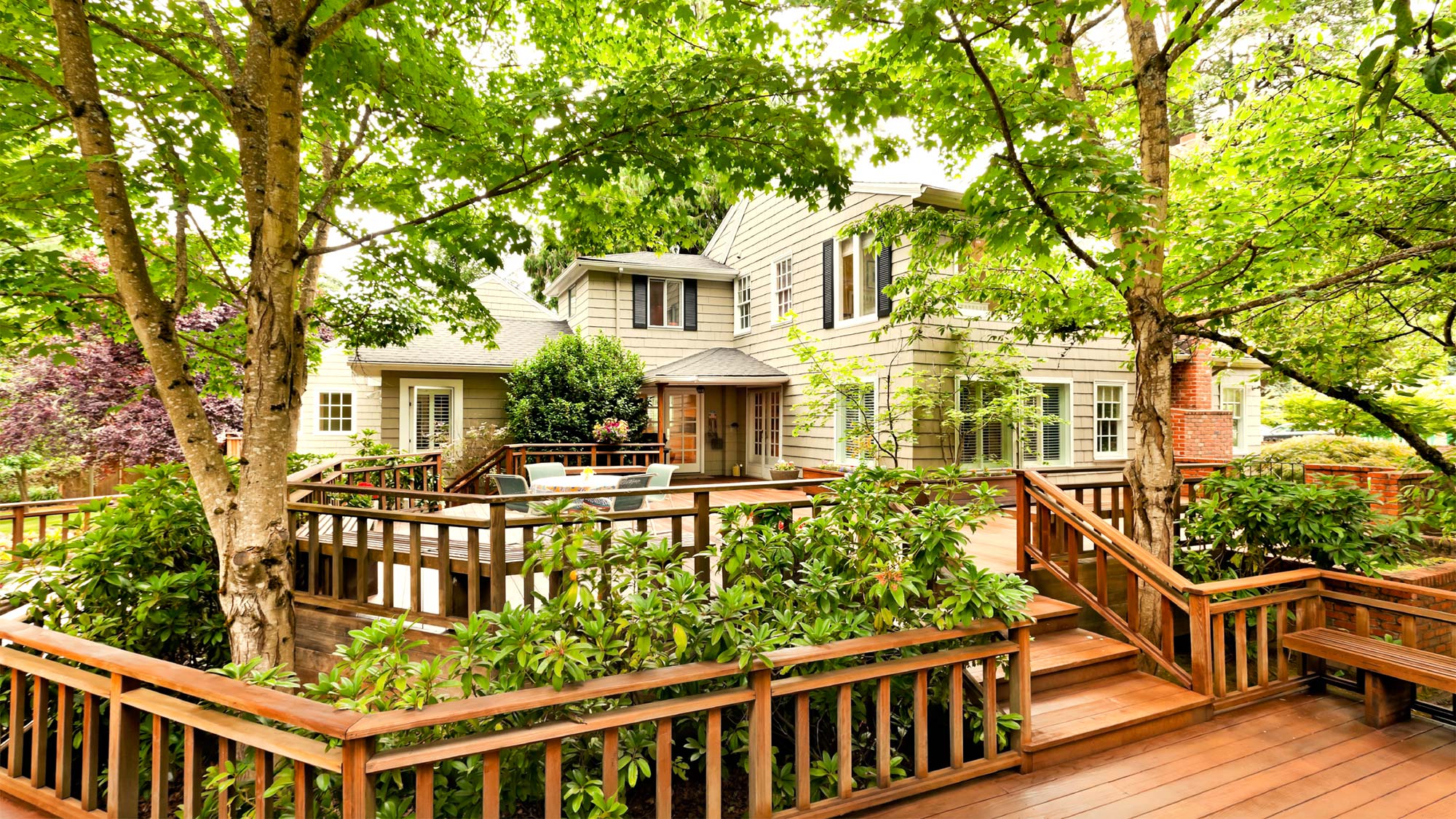6 Deck Renovations That Really Pay Off—and 1 That Doesn’t

If there’s one thing that unites this great country—especially once the weather starts getting warmer and barbecue season gets ever so tantalizingly closer—it is our passionate, even obsessive love for our outdoor decks. Truth be told, just about all of us desire a perch from which to survey our backyard (or rooftop) kingdom, lazily hang out, or busily entertain.
One story behind the origin of decks is that they were inspired by boat decking. But unlike new yawls or yachts—which will depreciate in value by an average of 24% in just three years—a brand-new wooden deck addition to your home will net you a 75% return on investment when you decide to sell, according to Remodeling Magazine’s 2016 Cost vs. Value Report.
That’s why in honor of summer’s sweet approach, we take a look at the ROI for decks in our latest installment of Renovations That Really Pay Off. Whether you are building one from scratch or just want to make the one you have bigger and better, here’s how to get your deck on this summer in ways that will pay off awesomely down the road.
Gratis guidance
Before you pick up a hammer, review the wildly useful free deck guide from the American Wood Council. Did we mention it’s free? Here you’ll find safe construction specs so you can get your rim joists and ledger boards just so. This should also be when you decide on deck size—a 200-square-foot deck will run you about $4,836—keeping in mind an addition could jack up your property taxes and insurance. Getting those hard numbers will help you figure out your overall budget (handy deck cost calculator here).
Getting started
The average contractor charges $35 per square foot to build a deck, but where the cost can vary enormously is in the material. Hollow-core PVC can cost as little as $7.50 per square foot, cedar even less at $3.50—while the Brazilian hardwood ipe goes for a nosebleed-inducing $22 or more (compare prices here).
A great way to save money? “Design your deck for standard lengths of lumber: 6-, 8-, 10-, or 12-foot boards,” says Chris Peterson, author of “Deck Ideas You Can Use.” This will eliminate any wasted wood from cutoffs. Peterson also suggests buying secondhand. “Organizations like Habitat for Humanity sell reclaimed wood from demos, as do some local salvage shops.” In addition to possibly scoring unique hardwoods, “the savings can be significant.”
Protect your investment
Your deck is constantly exposed to sun, rain, snow, and the occasional melted Creamsicle. Peterson advises “waterproofing wood decks regularly to ensure longevity … even if you’re letting the cedar or redwood age naturally. Water can cause direct damage in the form of rot and indirect damage like mold.”
Harry Adler of Adler’s Design Center & Hardware in Providence, RI, recommends protecting vulnerable surfaces with a product such as C2 Guard, a nontoxic waterproofer designed for use on unsealed wood and concrete surfaces.
Beyond wood
Pure, quality wood is the gold standard for decks. But there are other options, according to Bill Leys, aka The Deck Expert.
“Wood decks need yearly maintenance, and those costs can rapidly add up over the 20 years they’re expected to last,” Leys says.
James Brueton of EnviroBuild recommends using a quality wood composite, “which initially has a slightly higher cost. But without the need to treat the deck every year, you’re soon saving money over traditional wood.”
TimberTech is the only premium wood composite decking that is capped with a protective polymer on all four sides. Better yet, all TimberTech decking comes with a 25-year limited residential warranty.
Eye on entertaining
Outdoor entertaining should be the key focus of any deck design, Brueton says.
“Especially when reselling your home, any new buyer will immediately see the appeal of barbecue days and summer nights” on a deck, he says. Since all these revelers will need a place to sit, one easy way to add that is a built-in bench made out of the same wood as the deck itself. It generally offers a strong ROI.
This look is not only streamlined but also relatively budget-friendly, costing $500 to $1,500, says J.B. Sassano, president of Mr. Handyman, a national home improvement franchise. Best of all, such seats will withstand the elements as well as the flooring underneath.
That said, don’t throw style and comfort under the bus. Make sure to add cushions and choose at least one statement piece of furniture with a “pop of color to reflect your personality and design taste,” suggests Sassano. Like this bright yellow chair for $140.
Light the way
If you plan to hang out on your deck well after sunset, fireflies aren’t going to cut it as a light source. Modernize—a website that empowers homeowners to get home improvement projects done—suggests simple ground lights ($28 each) to stringing fairy lights (starting at $15) to solar lights.
Don’t play with fire
Built-in or portable fire pits are warm, cozy, and “the source of deck fires. Whether embers blow out of the pit or the heat from the pit ignites the wood deck, the result is often tragic, with homes burned to the ground,” says Leys. Er, not such a great ROI. Place your fire pit in the backyard far from anything flammable. And to safely heat things up on your deck, buy a patio warmer ($150 to $400) says Sassano.
—————-
This article originally appeared on Realtor.com

 Facebook
Facebook
 Twitter
Twitter
 Pinterest
Pinterest
 Copy Link
Copy Link
